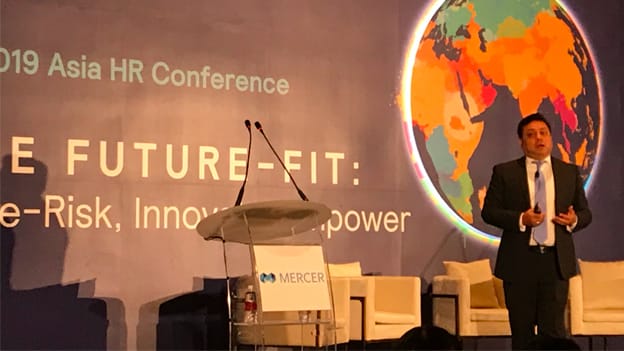Being future-fit for industrial revolution 4.0

Kick starting his keynote session at Mercer’s 2019 Asia HR Conference in Singapore on the theme “BE FUTURE-FIT: De-risk, Innovate, Empower”, Puneet Swani, Career Business Leader, International Region at Mercer, shared that HR needs to rethink strategic value and refocus on HR governance and operating model.
“The term ‘Future of Work’ has been doing the rounds for a while now, no conference appears to be complete without addressing the current status, challenges of the ‘future of work’ and what the time to come will unfold. Has anything changed though or are we still where we started,” he asked.
Progress has been made from speculating what the future would look like to understanding emerging trends. Focus over the years has shifted from identifying the risk of implementing new technologies to identifying ways to make technology work alongside people.
To understand what organizations are doing to be future fit, Mercer conducted a study at the beginning of 2019 covering 16 geographies, 9 different industries and nearly 7,000 employees, capturing perspectives of employees, HR as well as C-suite executives. They also identified practices of high-growth organizations for the industry to learn from. In his session, Puneet shared the key findings of the study and the existing and emerging trends and what the revised HR vision needs to focus on.
Insights from the survey
Global highlights:
- Building a diverse talent pool is the number one priority for US, followed by managing changing employee expectations and skills shortage
- Number one concern for UK, Italy, Singapore and Canada is skills shortage
- Middle East stated a heightened concern in women representation in leadership
- Consumer interest in ethical products has become a concern for Latin America at number 2
- 94 percent C-suite in Singapore is concerned about digital disruption and its impact, compared to 25 percent in 2018
Specific to Singapore the following statistics bring to light Singapore’s current status with respect to digital disruption:
Top Workforce concerns in Singapore:
- Skills shortage (58 percent)
- Gig economy (42 percent)
- Talent Diversity (42 percent)
- Multiple generations (40 percent)
- Women in leadership (40 percent)
The trending focus areas in Singapore include redesigning jobs, STEM education and digital collaboration, with creating development paths, advancing wellness efforts and delivering an advanced employee experience still remaining unresolved concerns.
Talent Migration is an upcoming concern for Singapore with the numbers nearly doubling as compared to 2018.
99 percent of companies in Singapore are taking action to prepare for the future of work, with agility being a key competency to drive the same.
The thought process and action-oriented plans lean towards:
- Mapping how technology will change the skills and behaviours needed (49 percent)
- Developing a people strategy based on future scenarios (43 percent)
- Redesigning jobs, roles and responsibilities (43 percent)
- Identifying how employee expectations support or disrupt changes (42 percent)
- Revisiting workforce plans to close the gap (37 percent)
The number one concern for executives is how to meet employee expectations for a consumer grade digital experience. As efforts are being made to digitize HR, the resulting employee experience remains a worry for employees, and therefore, executives. Singapore is investing in ‘AI in HR’ across multiple HR functions to standardize both practices and experience. Top five areas of AI investment in HR include:
- Leveraging AI to customize compensation to help in compensation benchmarking (39 percent)
- Using AI for chatbots, for looking up information (38 percent)
- Using AI to encourage managers to have conversations with employees (38 percent)
- AI in performance management (37 percent)
- Algorithms for screening and assessment in recruitment (34 percent)
Redesigning the HR vision to be future-fit
Changing times have brought about a change in confidence and priorities for HR. HR leaders are now driven to identify what skill modifications are required as a result of automation. Additionally, the focus is on reskilling those employees whose work was impacted by automation as well as providing outplacement services to workers who were displaced by automation; and hiring exceptional talent externally to fill in new open roles.
52 percent executives believe HR is effective in aligning people strategy with strategic business priorities. To streamline efforts, four trends to help HR prepare organizations to be future-fit include:
Aligning work to future value: Identify new value drivers to drive business strategies with an agile mindset, prepared to continuously learn. Speaking of agility Swani said, “Agility is where an organization is able to do different iterations, where each iteration doesn’t look like a step change, but it looks like part of an overall evolution.” Instead of thinking that ‘my organization keeps changing what it is doing, it doesn’t know what it wants,’ the mindset of employees needs to become agile and receptive to change. In line with the future value, identifying what skills will be needed as part of automation is a key focus area.
Value proposition to attract and retain talent: “Demographics and technology are pushing organizations to think through what is going to be the value proposition that you are going to offer me” said Swani. Practices and behaviours get amplified in the external world almost immediately, owing to the power of social media, which means organizations need to think about how they want to position themselves. HR needs to work across the segment of reward practices, include wellness, career management, a sense of purpose with corporate social responsibility as part of the value proposition. Cater to ethics, equity and empathy. Create your organization’s value proposition to create a sense of belongingness, to build an engaged workforce.
Simplify and create the right work environment: Enable quick-decision making and reduce the time invested by individuals on finding resources vs delivering the work. Simplify processes. Innovate existing approval and work processes to let individuals decide where, when and how they want to work. Create a work environment flexible enough with autonomy and accountability on the part of employees. Break stereotypes and encourage flexible work practices. Create flexible roles instead of employees having to ask for such policies. Understand the scope of each role and have built-in flexibility with respect to time and processes for every employee.
Keep people at the heart of all changes: All the organizational changes around technology that impacts skills creates a lot of fear and anxiety among employees that needs to be catered to. It is critical to keep employees at the heart of all the changes that are to be introduced as it impacts employee trust. Decline in employee trust will directly lead to an increase in attrition. HR perspective can no longer be about only implementing transformation activities. It is about how HR is involved in ideas and narration. It is about how HR impacts business conversations around workplace changes and workforce experience. Instead of using historical data on benchmarking and attrition, HR needs to leverage predictive models to make decisions and build a consumer grade digital experience for employees.
To prepare for the future of work, HR needs to transform to a more lean, agile and focused model, empowering the employee journey with digitization and keeping people at the centre of everything they do.














